This exercise is the opposite of the previous one which was concerned with freezing movement through very short shutter speeds. This exercise looks at use of long shutter speeds to capture an impression of movement within a still image.
The first part of the exercise involved some research into photographers who have used this technique.
Robert Capa
Robert Capa was a Hungarian photographer, famous for his war photography, who also co-formed the Paris-based Magnum Photos agency. The EYV coursebook presents one of his most famous images – a soldier wading ashore on Omaha Beach during the 1944 Normandy landings. This is a grainy, blurred shot. The coursebook also points out that Capa shot many much clearer images from the period of the D day landings, but the grainy, blurred one is the one that became “iconic”. Why is that?
 Copyright Magnum Photos
Copyright Magnum Photos
In fact, although Capa took a great many shots on D day and over the following days, due to an accident in processing only 11 images from the actual D day landings survived (Kuper, 2013). And of those, all of the ones that appear to show “action under fire” are blurred and grainy. So the question is not really why this particular image has become famous, but rather, would it still have become as famous if it were not blurred and grainy. I suspect it would, since an even more famous picture taken by Capa – the falling solder (below) – is not at all blurred.
 copyright Magnum Photos
copyright Magnum Photos
It is nevertheless said that “Capa understood the blurring effect” and that “sometimes he’d shake his camera to give pictures of war a sense of motion” (Kuper, 2013). But it’s unclear if the blur was deliberate in the D day shot, or a consequence of the limited light meaning he had to use a relatively long shutter speed and narrow depth of field.
Regardless of whether the result was intentional or accidental, I think the blur in the photograph creates a sense of confusion and urgency which we can reasonably presume must have been prevalent in the D day landings. Yet at the same time, the solder’s face is quite clearly presented, so we can recognise a specific person. The background is more blurred as if Capa took the shot while “panning”. So overall the image presents a picture of an individual, representing a collective effort, in a chaotic, urgent and dangerous endeavour. The soldier, incidentally, was called Ed Regan and you can see him being interviewed here explaining how frightened and exhausted he was.
(https://www.youtube.com/watch?v=HOpFQ2FneEk)
Reference
Kuper, S. “Interview: John Morris on his friend Robert Capa”, FT Magazine, 31 May 2013.
Hiroshi Sugimoto
Hiroshi Sugimoto is a concept photographer. The EYV coursebook refers us to a youtube clip which explains his approach (https://www.youtube.com/watch?v=_2XUtoTRjtc). Among other series he has photographed the interiors of cinemas over the entire duration of a film. The result of this long exposure is an entirely white screen and the apparent disappearance of all the people, so that only the furnishings of the cinema are visible. Personally I find the images rather less interesting than Sugimoto’s philosophical explanation: “too much information ends up with nothingness”. The main thing I think is noteworthy about the images is that while a long exposure usually leads to an impression of movement, in this case it suggests the complete opposite. The image is entirely static looking.

Michael Wesely
Michael Wesely is a photographer who has taken images, often of large scale construction projects, over periods of months or even years. The resulting pictures don’t so much show movement, but rather change, and in some cases have the appearance of having combined several different images (resulting from different stages of construction being captured in a single exposure).

The lines in the sky are created by the sun tracing a different day – and clearly some days will have been overcast so there are some gaps. Wesely has said that: “the lines in the sky put our existence, us, our planet into context with the Dance of the Universe, which coexists on an entirely different time scale” (http://itchyi.squarespace.com/thelatest/2010/7/20/the-longest-photographic-exposures-in-history.html).
Some experiments
The next part of the exercise asked me to use slow shutter speeds, multiple exposure, or some other technique expired by the examples above, to try to record a trace of movement.
Before I took the pictures I generated a bit of a mental checklist of the types of things I could do using the equipment available. These were as follows:
1. Camera stationary, subject moving or changing. This is in effect what Sugimoto and Wesely above have done.
2. Camera moving, subject stationary. The camera can be moved in various different ways – e.g. up and down, left and right, forwards and backwards, pivoting, twisting.
3. Camera and subject moving. There are a couple of possibilities here. One is that the camera and subject are moving in such a way that the subject still appears relatively clear (i.e. relative to each other, the camera and subject are not actually moving very much, e.g. panning). The other is where the movement of the camera and subject are independent of each other.
I tried to take a few pictures covering these various permutations. Here they are.
Camera and subject (myself) more or less stationary relative to each other, but both moving. This is a “selfie” taken while spinning round on a chair. 8 secs at f11.
Camera stationary, subject moving. Another “selfie”. In this one I progressively moved my position towards the camera. 6 secs at f11.
Camera and subject moving independently. This was hand held, at waist level, while I was walking down the street one way and this chap passed me on a skateboard going the other way. 1/3 sec at f11.
Camera and subject both moving but stationary relative to one another. This is my friend Shaun on a train. The background is whizzing by at around 70mph so is completely blurred. 1/8 sec at f4.5.
Camera stationary and subject moving. Ice skating in Bristol. 1/4 sec at f11
Camera moving, subject stationary. I was twisting the camera as I took this picture of Alfred. I tried to put his left eye in the centre to keep that as a relatively undistorted feature. 1/4 sec at f22.
Camera moving, subject stationary. Similar to the above except in this one I quickly zoomed in after pressing the shutter. Again I put the left eye centre shot. 1/3 sec at f22.
Camera moving, subject stationary. This is St Werburgh’s in Bristol, taken while moving the camera up and down. Quite a pleasing result and vaguely Turner-esque. 1/8 sec at f22.
I slightly lost the plot here and can’t remember exactly what we were doing, but it looks like we were both moving, and the end result is interesting. 1/5 sec at f8.
Camera and subject moving. In this one I was trying to pan the camera to keep Alfred’s head reasonably clearly defined as he passed by. 1/13 sec at f8.
I also took this series of long exposure night shots on a recent trip to London, all using a tripod. Exposures were typically around 10-15 seconds.


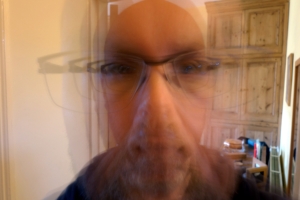

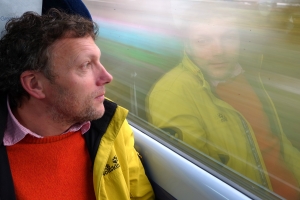








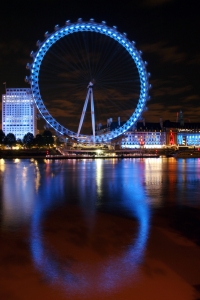
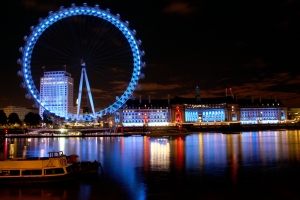
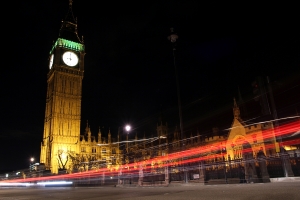


This was a very useful to me in getting my head around the start of the next project. I am planning to shoot some elements for assignment 4 on light whilst its so dark and not getting out and about much. You might want to come to Bath to see Bath Spa university project http://illuminate2015.org/
LikeLike